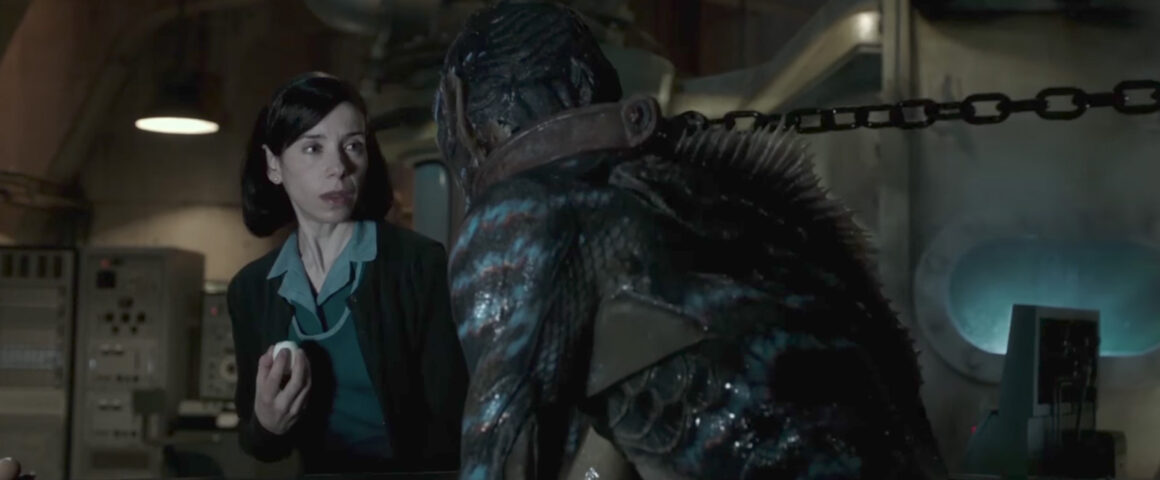While we know that some monsters are decidedly not lovable, the creature in Mexican director Guillermo del Toro’s The Shape of Water, like many humans who roam the planet, is more of a lonely outcast seeking connection than a life-threatening presence. Performed by Doug Jones (“The Bye Bye Man”) underneath all the prosthetics, this monster is an amphibian humanoid known as the Asset, captured by scientists from the Amazon (the one in South America) to help with the U.S. space program. Amphibian man (as he is listed in the credits) resembles a cross between King Kong and E.T., though definitely not as cuddly as the latter but a much better dancer.
The Asset is also an unabashed romantic who loves hard-boiled eggs, which is even strange for a human and enjoys Benny Goodman which is not as strange but, as del Toro says, “What is ridiculous can also be sublime.” Sublime or not, The Shape of Water is an engaging if predictable “fantasy for adults” as del Toro characterizes it. The film explores the connection between the amphibious man and Elisa Esposito (Sally Hawkins, “Maudie”), a mute janitor who works the night shift in the Occam Aerospace Research Center. Elisa lives by herself in Baltimore in an apartment above an old-fashioned movie palace that plays biblical epics in Cinemascope to a few remaining diehards.
Set in the early 1960s during the Cold War, stereotyped forever as an age of social conformity, the film seems to be a warning to those who look back on the golden days with starry eyes by showing us how a part of our history has been marked by racism, homophobia, and xenophobia. In the opening scene, Elisa is asleep in a room filled with water as the narrator, whom we later find out is her neighbor Giles (Richard Jenkins, “White House Down”), describes her as a princess in a fairy tale and Alexandre Desplat’s score persuades us that the world is filled with childlike wonder, but it is a hard sell. As Elisa awakens from her dream, she goes about her routine — making hard-boiled eggs, taking a bath, making sandwiches and watching TV with Giles who is a gay commercial artist and has just lost his job for reasons unspecified, but we can guess.
Though unable to speak, Elisa communicates at work with Zelda (Octavia Spencer, “Hidden Figures”), a supportive friend and co-worker who knows sign language. Elisa’s routine undergoes a radical shuffling when the Asset arrives in a pressurized water tank. Controlled by arch-villain Colonel Richard Strickland (Michael Shannon, “Nocturnal Animals”) who carries a cattle prod and who we quickly realize is the real monster in the film. Strickland plans to send the Asset into outer space where, if he wasn’t lonesome before, he will now really know what lonesome is. The self-righteous and bullying Strickland is responsible for protecting the fish-man from the Russians who he fears may snatch him to either kill him or use him to gain an advantage for their space program.
Tentative at first, Elisa senses that she has something going with the Asset and teaches him sign language which proves he has a good head on his shoulders as well as other functioning body parts. She then introduces him to the hard-boiled egg which he devours and soothes him with the music of Benny Goodman as they do a perfect imitation of Ginger Rogers and Fred Astaire. Underneath her outward persona, Elisa has a big heart and big ideas. Once she learns that Strickland wants to cut her new friend open to better understand how he breathes, she makes plans to capture the sexy creature and put him in her bathtub until he can be released into the ocean at high tide.
Aiding her in her scheme are the Russian mole, Dr. Robert Hoffstetler (Michael Stuhlbarg, “Call Me by Your Name”), Giles, unfortunately stereotyped as being weak and fearful, and Elisa’s dependable friend Zelda who joins the group as a late arrival. The heist itself is genuinely exciting and the strongest part of the film with much of the pleasure seeing the expressions on Strickland’s face. From the capture, there is the chase, and then the romance which is unorthodox to say the least, all taking place as the sadistic Strickland displays fewer and fewer redeeming qualities.
The Shape of Water has some lovely moments and unique special effects, and the inclusion of pop songs from the 1940s such as “You’ll Never Know” from “Hello, Frisco, Hello,” and Glenn Miller’s rendition of “I Know Why (and so do you),” from the film “Sun Valley Serenade” help to capture the aura of nostalgia. Unfortunately, however, the film’s potential is thwarted by one-dimensional characters who hammer us constantly with a message that we have already figured out. While The Shape of Water shouts “magic and wonder,” it ultimately falls short of conveying it.




'Movie Review: The Shape of Water (2017)' has 1 comment
December 18, 2017 @ 6:49 pm JaredR.
It’s such a beautiful movie. I had no idea I could be so emotional over a relationship between a sea creature and a woman.